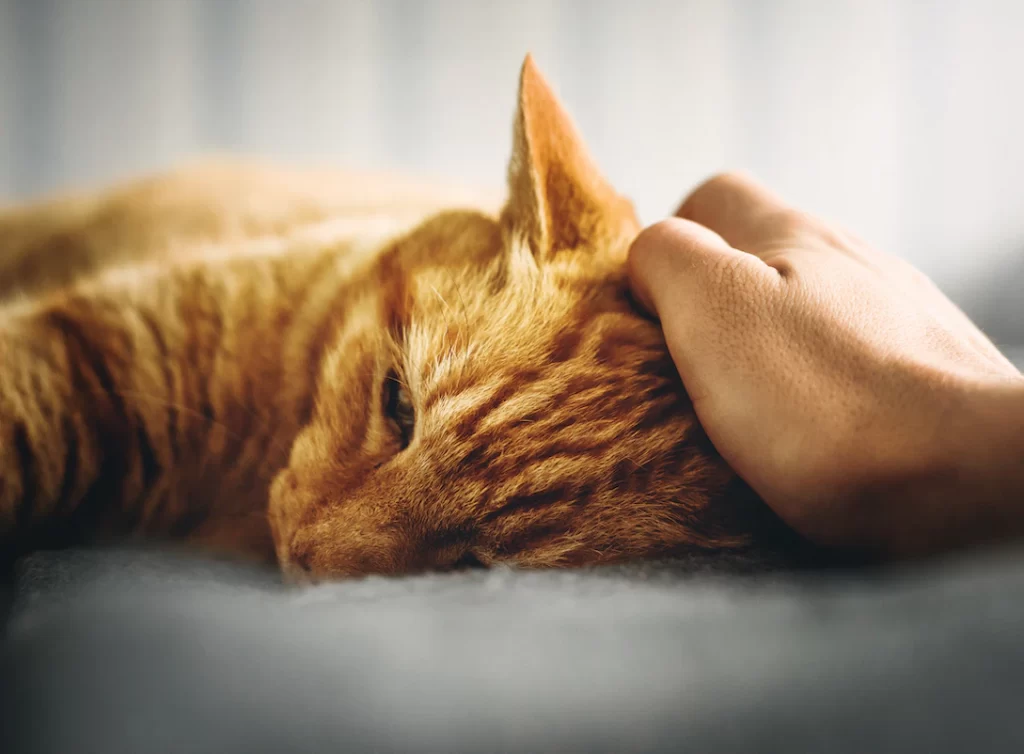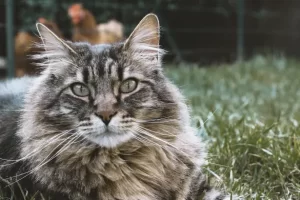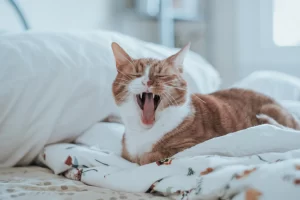Last updated on February 20th, 2023 at 12:19 am

So your cat vomits after eating? When you feed your cat, you might notice them vomiting after now, and then, you might get worried about the issue. Vomiting after eating can be a sign of a variety of conditions and diseases, some of which can be serious. If your cat vomits after eating, it is important to take note of the timing and frequency of the vomiting. Vomiting once or twice in a day is usually nothing to be concerned about and may be a sign that your cat has eaten too much or too quickly. However, if your cat vomits more than twice a day or if there is a change in the color or consistency of the vomit, it is important to consult your veterinarian to determine the underlying cause.
There are two types of vomiting. Acute and chronic vomiting. Acute vomiting can be caused by dietary indiscretion, infection, toxins, or other underlying medical conditions. The most common cause of acute vomiting in cats is dietary indiscretion, which can be caused by a change in diet or simply eating something that is not appropriate for cats. Infection and toxins are also common causes of acute vomiting.
Chronic vomiting in cats can be caused by a variety of underlying medical conditions, including inflammatory bowel disease, food allergies, pancreatitis, kidney disease, and cancer. Chronic vomiting goes on for a long time and a cat throws up 1 or 2 times a day. In this article, we shall look at some causes of vomiting and how to prevent your cat from vomiting.
Reasons Why Your Cat vomits After Eating
1. Too much feeding
Just like human beings, when you overate, there is a likelihood of getting stomach upset or even vomiting. A cat at times gets overwhelmed by a certain type of meal. The most common cause of vomiting after eating is eating too much or too quickly. Cats often eat too much because of a diet consisting of too many carbohydrates and not enough protein, or because of a diet that is too high in fat. Eating too quickly can cause vomiting, as can eating poor-quality food or food with preservatives or artificial flavors. If your cat is vomiting after eating, try to feed smaller meals that are higher in protein and lower in carbohydrates and fat.
2. When the cat eats or drinks too fast
Have you fed your cat and noticed some liquid on your cat’s food? It might be vomit. When you own more than one cat, there is a feeding problem. Some cats will eat other cats’ food. It makes your cats acquire irregular feeding habits. When the cats are too many, some tend to eat too fast so that they can feed on the other food belonging to other cats. To solve the problem, you can have different feeding areas for each cat. Otherwise, you can get an electric feeder. Ensure that your cats have a bowl of water to ensure that they do not vomit in case of eating too fast.
3. Hairballs
It is a normal thing for your cat to swallow hairballs when grooming themselves. After this procedure, you might notice your cat vomiting hairballs. If this trend goes on several times, you can ask the vet for ways to reduce the issue. You might be advised on diets that can reduce hair formation or rather than your cat grooming itself, you can do it for them. Blue Buffalo food has a way of reducing hairball formation in the stomach of your cat. There is other cat food that helps hairballs penetrate through the intestinal tract. Such cat foods include Richard’s Organic hairball formula.
4. Feed your cat food that is hard to digest
Your cat goes hunting from time and feeds on animals and insects such as bugs, birds, and rats. This means that they are feeding on fats, proteins, and animal bones. However, cat food has some bones and organs too. These types of food provide nutrients to the cat but at times is hard to digest. It is advisable to switch from these kinds of food. There are feeds that contain a single protein that is easy to digest such as Cat Man Doo Freeze Dried Chicken Treat.
Also read: Best healthy cat treats for your cats
5. Ingredients present in the food
Most cat owners do not pay close attention to the ingredients that are used to make the cat food. As a cat owner, you want the best quality food for your cat or kitten. In case the cat food contains additives, surfactants, and preservatives, they may cause vomiting. The cat food has food labels on them that you should check before feeding your cat. At times you might think that some ingredients may affect your cat either positively or negatively. You need to educate yourself on the ingredients that work best for your cat and stick to the recipes or type of food.
6. Eating spoiled food
Eating spoiled food can cause your cat to vomit after eating. Spoiled food can contain bacteria that can make your cat sick.
7. Lack of grooming
Your cat vomits when they feed on hairballs. In most cases, this happens when they groom themselves. Hairballs are difficult to digest thus they may vomit. When you groom your cat, it does not get in contact with the hair. You need to groom your cat at least once a week. Get some grooming tools such as Furminator that can get rid of loose hair and leave your cat looking beautiful. Some cats cannot stay still and get groomed. If your cat is uneasy, get them some nibbles to help them settle down as you trim their fur.
Also read: Best Cat Grooming Tools Every Cat Owner Wants
8. Underlying health conditions
When your cat vomits after eating repeatedly, there must be an underlying condition. The cat may be experiencing some health issues such as:
- Acute kidney failure occurs due to the presence of toxins in the liver or kidney. It causes poor blood flow thus leading to blockages in the kidney.
- Inflammatory Bowel Disease. This condition happens when the gastrointestinal tract is irritated chronically and gets inflamed.
- Pancreatitis is a condition where the pancreas gets inflamed that happens due to blockages or damage to the pancreas.
9. Allergies
Cats may have food allergies that can cause them to vomit after eating. If your cat is eating food that contains ingredients, they are allergic to, they may vomit after eating.
What to do to stop your cat from vomiting after eating
- Have a feeding schedule
You should feed your cat on schedule to prevent them from overfeeding which causes vomiting. You can have a normal human timetable where they can feed two to three times a day. With this, they will not overeat, and the cat will not vomit after eating. You also need to put a portion of food that your cat can feed on and get full instead of overfeeding. With schedules, the cat will have time to get the food digested without any further complications. In other instances, if you have many cats, have different areas from where they can feed so that they can eat equal food.
- Avoid feeding your cat table scraps
Table scraps are often high in fat and can be difficult for cats to digest, leading to vomiting.
- Keep your cat’s food and water bowls clean:
Make sure that your cat’s food and water bowls are clean and free of any residue that could be making your cat sick.
- Feed your cat a high-quality diet
Feed your cat a high-quality diet that is specifically formulated for cats. This will ensure that your cat is getting all the nutrients it needs without any unnecessary fillers.
- Avoid sudden diet changes
Sudden changes to your cat’s diet can cause digestive upset, leading to vomiting. If you need to make changes to your cat’s diet, do it gradually.
- Use electric feeding machines
Feeding machines are more accurate than human beings. If you are busy at work, you do not need to leave your cat’s bowl filled with food which might result in overfeeding. The feeding machine has a time setter that feeds the cat at intervals to ensure that it is not overfed or underfed. If you travel for work maybe for some weeks, the electric feeding machine will ensure that your cat is taken care of in terms of meals. The machine also ensures that the balance is balanced.
- Take care of your cat grooming
Your cat vomits after eating due to the presence of hairballs in the stomach. The hairballs may block the intestines from digestion thus leading to vomiting. All you need is to groom your cat or look for someone who is good at the grooming process. A cat may swallow the fur when grooming itself whereby the fur accumulates in the stomach. The more the fur accumulates in the stomach the more the digestion sector becomes complicated. You can look for methods to groom your cat online depending on the amount of fur. Try and brush your cat daily with a soft brush to ensure that it does not need to groom itself.
- Get rid of plastics and plants that may lead to indigestion
Your cat might be vomiting after feeding because they have swallowed some plastics from eaten plants that may cause slow or no digestion. Your cat may eat plastics that are harmful to the digestion sector which makes the cat vomit after eating. When your cat feeds on some plants, they harm your cat which may cause indigestion issues. You need to put the harmful plants and any chewable plastics away from the cats.
How to prevent your cat from vomiting in the future
1. Ensure that your cat is dewormed frequently
Your cat may vomit since you forget deworming it. In most cases, lack of deworming may cause vomiting which is due to irritations. You need to consult the vet and get the best medication for deworming. You can visit a pet store and get the best advice concerning the best medicines to deworm your cat. Ask for the frequency at which you should deworm your cat to avoid future health issues.
2. Feed your cat high-quality, species-appropriate food
Make sure your cat is being fed a balanced, nutritious diet with high-quality, species-appropriate ingredients. If your cat is a picky eater, try offering a variety of wet and dry foods in different textures and flavors.
3. Observing your cat’s behavior
Your cat might be having some health issues that lead them to vomit when they eat. You need to be keen on any change of behavior in your cat. You can also have regular visits to the vet so that the vet can notice any issues that may be changing the eating patterns and vomiting. Visiting the vet will also help you diagnose some diseases that make your cat vomit after eating. Some behaviors may be lack of energy, being too active and cat looking tired.
4. Use OTC hairball remedies
There are companies that produce food that ensure that hairballs can penetrate the colon. Blue Buffalo Company is a perfect example of such a kind of company. Once your cat eats the food, it will not vomit. These feeds should be used frequently to ensure that the cat does not experience digestion issues.
5. Monitor your cat’s weight
Obesity can lead to a variety of health issues, including vomiting. Feed your cat a balanced diet and monitor his weight to make sure he is not overweight.
6. Check on the food you are feeding your cat
Some types of food might harm your cat where they vomit after eating. This mostly happens when you switch the type of food you have been feeding your cat. As you change your cat’s diet, ensure that it is close to what you feed them or observe the reaction after feeding the cat.
Conclusion
Vomiting in cats is a common problem that can often be prevented with proper nutrition, regular veterinary care, and a stimulating environment. To prevent your cat from vomiting in the future, you should provide your cat with a high-quality, balanced diet and make sure they are getting the necessary vitamins and minerals. Talk to your vet about the best diet for your cat based on their age, activity level, and any existing health conditions. Additionally, make sure to feed your cat on a consistent schedule and provide them with plenty of fresh, clean water. Lastly, it is important to provide your cat with a stimulating environment that is free from stress, boredom, and loneliness.


